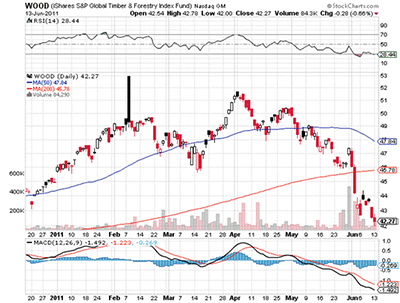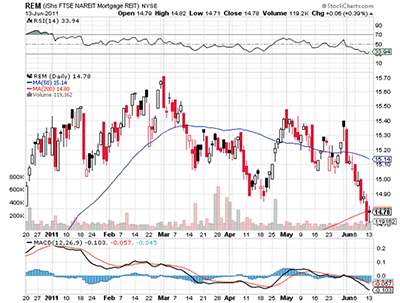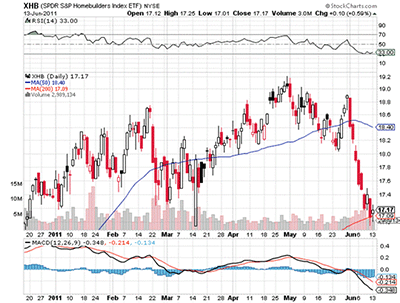With the US housing market now officially in a double-dip recession, these three ETFs, which track building materials, mortgage REITs, and homebuilders, are all in danger of sustaining steep new losses.
By many measures, the US economy has come a long way since the depths of the most recent recession. Since bottoming out in early 2009, most equity indexes have climbed sharply higher and reclaimed much of the ground lost during the preceding freefall.
GDP growth has swung back into positive territory, the US government has closed out its positions in many bailed-out institutions (in some cases booking a gain in the process), and retirement portfolios across the country have bounced back.
But there are plenty of reminders that we’re not out of the woods yet, and that the journey back to economic superpower status is a long road.
Job creation has been scarce, as the unemployment rate has continued to tease double digits, and more meaningful metrics put the jobless rate much higher. Washington’s debt burden continues to climb, setting the stage for an epic showdown that could result in a historic default (though that extreme scenario remains unlikely). And perhaps most importantly, housing prices are continuing to show extreme weakness, a negative development that has the potential to ripple throughout the global economy.
The US housing market recently hit a confirmed double dip, as prices have dropped to levels not seen since 2002. This downward trend was confirmed when the S&P/Case-Shiller national home price index, an index that covers 80% of the housing market, reported its third straight quarterly loss.
While some point to a lagging economy as the culprit of this double dip, others point out that tax credits—which helped pull housing out of its original tailspin—have since expired, perhaps creating less demand in the battered sector.
Now that a double dip has been confirmed, all eyes are on the housing market to see how it will handle yet another recessionary period. While many will be hoping for a recovery in the next few years, it seems that Robert Shiller, co-creator of the Case-Shiller index, does not feel this is likely.
Shiller is “optimistic” that home prices will continue to slide for two decades, saying “It’s a good thing for America if the housing construction industry gets ever more efficient.” That attempt at a silver lining will likely do little to placate those who see recovery in the nation’s housing market as a key component of a broad economic resurgence.
NEXT: Three Vulnerable ETFs Revealed
|pagebreak|Three Vulnerable ETFs Revealed
The ever-growing lineup of ETFs gives investors tools for playing virtually every economic trend or development, and the housing tumble is no exception. Most of the products in the ETFdb real estate category don’t have much of a connection to housing prices; these funds consist of REITs whose interests are primarily in commercial and industrial real estate (which is generally impacted more by employment rates).
But for investors with a strong outlook on where home prices go from here, there are a few funds that may be useful tools for implementing a tactical tilt.
iShares S&P Global Timber & Forestry Index Fund (WOOD)
WOOD is a rather unique product, seeking to replicate a benchmark that measures the performance of companies engaged in the ownership, management, or upstream supply chain of forests and timberlands. Top holdings in the fund feature names like Plum Creek Timber Company (PCL) and Sino-Forest (TRE) among a total of 31 securities.
The US is by far the largest single-country allocation (nearly half the fund), with the other 50% of assets spread across a number of emerging and developed markets.
Here’s a recent daily chart:
If the dip in housing continues, it can only mean bad news for timber, as construction companies’ demand for wood will dampen. With less demand for timber in the US, this fund will likely take a hit as supplies stockpile and prices for wood decline.
It is also important to note that the US imports a fair amount of its wood products from foreign nations, but this will likely slow for as long as the housing market stays depressed, spelling bad news for the international half of WOOD as well.
NEXT: ETF That Tracks Mortgage REITs
|pagebreak|iShares FTSE NAREIT Mortgage REITs Index Fund (REM)
REM is a popular REIT product that tracks an index seeking to measure the performance of the residential and commercial real estate, mortgage finance, and savings associations sectors of the US equity market. Top holdings tend to favor medium-cap companies, with names like Annaly Capital Management (NLY) and Hatteras Financial (HTS) making an appearance.
Though REM is down so far this year, it may have appeal to investors seeking current returns; the anxiety in real estate markets has created a 30-day SEC yield of about 10.4% for this fund.
Here’s a recent daily chart:
It is also important for investors to note that 72.5% of the fund is made up of mortgage REITs, which can lead to increased sensitivity to the housing market.
REM is different from many real estate ETFs, however. Some investors assume that weakness in housing markets translates into a poor outlook for REITs, but this is not necessarily the case. Most REITs actually hold industrial and commercial buildings, and any “residential” exposure comes through ownership of apartment buildings. Depending on the makeup of a REIT product, its return drivers will be very different from that of another product.
Many of the REITs found in REM invest in US residential mortgage-backed securities, including assets guaranteed by Fannie Mae, Freddie Mac, and Ginnie Mae. That makes this fund somewhat sensitive to the health of the housing market. Falling home prices put more homeowners underwater, leading to a climb in default rates and a drop in value of the underlying components.
NEXT: A Popular Homebuilders ETF
|pagebreak|SPDR Homebuilders ETF (XHB)
XHB is linked to an index that represents the homebuilding sub-industry portion of the S&P Total Markets Index, and this fund has tumbled in recent weeks as worries about a prolonged stretch of weakness in housing markets have intensified.
Many of XHB’s component stocks are companies whose operations consist of new home construction. Dips in housing prices lead to decreased demand for the services provided by the Toll Brothers (TOL) and Pulte Groups (PHM) of the world, as more Americans elect to stay put and hold off on new construction products.
Here’s a recent daily chart:
A weak housing market also hurts the “indirect” homebuilding companies that are included in XHB, names like Pier 1 Imports (PIR) and Tempur-Pedic International (TPX). As groundbreakings on new residential complexes grind to a halt, the need for beds, decor, and other home-related products takes a dive as well.
By Jared Cummans, contributor, ETFdb.com
























